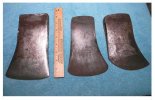Stropping Young Lad
Gold Member
- Joined
- Dec 11, 2012
- Messages
- 2,149
Hi all. This feels like a stupid question, but how can you tell if a bit is worn out? I have a few old axe heads I was thinking about fixing up and using, but I wanted to make sure the bit metal isn't too worn down. Honestly, I can't tell the difference by looking at it.
Can anyone explain this?
Can anyone explain this?




